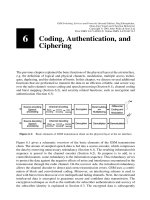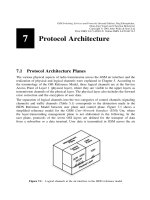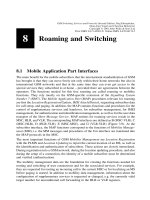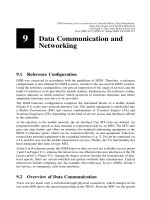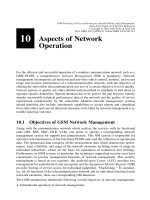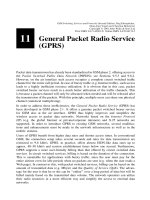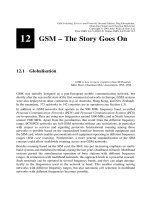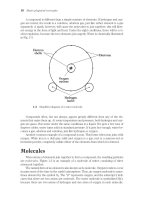Tài liệu GSM Switching, Services and Protocols P1 pdf
Bạn đang xem bản rút gọn của tài liệu. Xem và tải ngay bản đầy đủ của tài liệu tại đây (159.42 KB, 8 trang )
Introduction
1.1 Digital, Mobile, Global: Evolution of Networks
Communication everywhere, with everybody, and at any time ± we have come much
closer to this goal during the last few years. Digitalization of communication systems,
enormous progress in microelectronics, computers, and software technology, inventions of
ef®cient algorithms and procedures for compression, security, and processing of all kinds
of signals, as well as the development of ¯exible communication protocols have been
important prerequisites for this progress. Today, technologies are available that enable the
realization of high-performance and cost-effective communication systems for many
application areas.
In the ®eld of ®xed networks ± where the end systems (user equipment) are connected to
the network over a line (two-wire copper line, coaxial cable, glass ®ber) ± new network
technologies (such as xDSL and cable modem) have been introduced, providing broadband
access to the Internet.
The largest technological and organizational challenge is, however, the support of subscri-
ber mobility. It can be distinguished between two kinds of mobility: terminal mobility and
personal mobility.
In the case of terminal mobility, the subscriber is connected to the network in a wireless
way ± via radio or light waves ± and can move with his or her terminal freely, even during a
communication connection. The degree of mobility depends on the type of mobile radio
network. The requirements for a cordless in-house telephone are much less critical than for
a mobile telephone that can be used in a car or train. If mobility is to be supported across
the whole network (or country) or even beyond the network (or national) boundaries,
additional switching technology and administrative functions are required, to enable the
subscribers to communicate in wireless mode outside of their home areas.
Such extended network functions are also needed to realize personal mobility and univer-
sal reachability. This is understood to comprise the possibility of location-independent use
of all kinds of telecommunication services ± including and especially in ®xed networks.
The user identi®es himself or herself (the person), e.g. by using a chip card, at the place
where he or she is currently staying and has access to the network. There, the same
communication services can be used as at home, limited only by the properties of the
1
GSM Switching, Services and Protocols: Second Edition. Jo
È
rg Eberspa
È
cher,
Hans-Jo
È
rg Vo
È
gel and Christian Bettstetter
Copyright q 2001 John Wiley & Sons Ltd
Print ISBN 0-471-49903-X Online ISBN 0-470-84174-5
local network or terminal used. A worldwide unique and uniform addressing is an impor-
tant requirement.
In the digital mobile communication system GSM (Global System for Mobile Commu-
nication), which is the subject of this book, terminal mobility is the predominant issue.
Wireless communication has become possible with GSM in any town, any country, and
even on any continent.
GSM technology contains the essential ``intelligent'' functions for the support of personal
mobility, especially with regard to user identi®cation and authentication, and for the
localization and administration of mobile users. Here it is often overlooked that in mobile
communication networks by far the largest part of the communication occurs over the
®xed network part, which interconnects the radio stations (base stations). Therefore it is no
surprise that in the course of further development and evolution of the telecommunication
networks, a lot of thought is given to the convergence of ®xed and mobile networks.
Today, GSM is used mainly for speech communication, but its use for mobile data
communication is growing steadily. The GSM Short Message Service (SMS) is a great
success story: several billion text messages are being exchanged between mobile users
each month. The driving factor for new (and higher bandwidth) data services is the wire-
less access to the Internet. The key technologies that have been introduced in GSM, the
General Packet Radio Service (GPRS) and the Wireless Application Protocol (WAP), are
also explained in this book.
The next generation of mobile communications is known as Universal Mobile Telecom-
munication System (UMTS) in Europe and as International Mobile Telecommunication
System 2000 (IMT-2000) worldwide. The standardization has already progressed quite far,
such that the ®rst networks are expected to start operation in 2002. Despite the differences
to GSM (in particular with regard to transmission technique and capacity), it is a clear goal
of this future network technology to keep the newly introduced GSM technologies and
make them essential components of UMTS/IMT-2000.
1.2 Classi®cation of Mobile Communication Systems
This book deals almost exclusively with GSM; however, GSM is only one of many facets
of modern mobile communication. Figure 1.1 shows the whole spectrum of today's and ±
as far as can be seen ± future mobile communication systems.
For the bidirectional ± and hence genuine ± communication systems, the simplest variant is
the cordless telephone with very limited mobility (in Europe especially the DECT stan-
dard). This technology is also employed for the expansion of digital PBXs with mobile
extensions. A related concept is Radio in the Local Loop (RLL) or Wireless Local Loop
(WLL). Both concepts require only limited mobility.
Local Area Networks (LANs) have also been augmented with mobility functions: Wireless
LANs have been standardized and are now offered by several companies. WLANs offer IP-
based, wireless data communication with very high bit rates but limited mobility. IEEE
802.11 systems transmit up to 11 Mbit/s, and HIPERLAN will offer up to 25 Mbit/s. Both
systems form pico-cellular networks. They are installed, for example, in of®ce environ-
1 Introduction
2
ments and airports, as supplement or alternative to wired LANs, and they are also consid-
ered to be a good supplement to UMTS access technologies. The efforts to ``mobilize'' the
Internet are also worth mentioning in this context. A new routing protocol called Mobile IP
[48,49] has been developed, which allows a mobile computer to change its point of
attachment to the Internet. A further strong innovation impulse for mobile data and multi-
media communication is the development of wireless Mobile ATM systems based on the
exchange technology Asynchronous Transfer Mode (ATM).
Another emerging class of wireless networks is used for short-range communication.
Bluetooth, for example, replaces cables by enabling direct wireless information exchange
between electronic devices (e.g. between cellular phones, Personal Digital Assistants
(PDAs), computers, and peripherals). These networks are also called Body Area Networks
or Personal Area Networks. Unlike the mobile technologies mentioned above, they are not
based on a ®xed network infrastructure (e.g. base stations). The possibility of building up
1.2 Classi®cation of Mobile Communication Systems
3
Figure 1.1: Overview of contemporary and future mobile communication systems
such networks in a spontaneous and fast way gave them the name ad hoc networks. WLAN
technologies also include the capability for peer-to-peer ad hoc communication (besides
the classical client-to-base station transmission modus).
GSM belongs to the class of cellular networks, which are used predominantly for public
mass communication. They had an early success with analog systems like the Advance
Mobile Phone System (AMPS) in America, the Nordic Mobile Telephone (NMT) in Scan-
dinavia, or the C-Netz in Germany. Founded on the digital system GSM (with its variants
for 900 MHz, 1800 MHz, and 1900 MHz), a market with millions of subscribers world-
wide was generated, and it represents an important economic force. A strongly contribut-
ing factor to this rapid development of markets and technologies has been the deregulation
of the telecommunication markets, which allowed the establishment of new network
operators.
Another competing or supplementing technology is satellite communication based on Low
Earth Orbiting (LEO) or Medium Earth Orbiting (MEO) satellites, which also offers
global, and in the long term even broadband, communication services. Trunked radio
systems ± in digital form with the European standard Trans European Trunked Radio
(TETRA) ± are used for business applications like ¯eet control. They offer private services
that are only accessible by closed user groups.
Besides bidirectional communication systems, there also exists a variety of unidirectional
systems, where subscribers can only receive but not send data. With unidirectional
message systems (paging systems) users may receive short text messages. A couple of
years ago, paging systems were very popular, since they offered a cost-effective reach-
ability with wide-area coverage. Today, the SMS in GSM has replaced the function of
paging systems. Some billion SMS messages are being exchanged between mobile GSM
users each month. Digital broadcast systems, such as Digital Audio Broadcast (DAB) and
Digital Video Broadcast (DVB), are very interesting for wireless transmission of radio and
television stations as well as for audio- and video-on-demand and broadband transmission
of Internet pages.
The path to the future universal telecommunication networks (UMTS/IMT-2000) has been
opened with the realization of the personal communication services, Universal Personal
Telecommunication (UPT), based on intelligent networks. During the last few years, the
huge success of GSM as well as the exploding number of Internet users gave the design and
development of third generation mobile systems a new orientation: One of the most
important goals in the evolution from GSM to UMTS is to offer an ef®cient and powerful
mobile access to the Internet.
GSM and its enhancements, however, will remain for many years the technological base
for mobile communication, and it continues to open up new application areas. At the
moment, the area of mobile e-commerce (e.g. mobile payment with cellular phones,
mobile banking) is particularly attractive. Also text-based news services, locating, ¯eet
management, telemetry applications, and automatic emergency call systems are of great
interest. The techniques and procedures presented in this book are the foundation for such
innovative applications.
1 Introduction
4
1.3 Some GSM History and Statistics
In 1982 the development of a pan-European standard for digital cellular mobile radio was
started by the Groupe Spe
Â
cial Mobile of the CEPT (Confe
Â
rence Europe
Â
enne des Admin-
istrations des Postes et des Te
Â
le
Â
communications). Initially, the acronym GSM was derived
from the name of this group. After the founding of the European standardization institute
ETSI (European Telecommunication Standards Institute), the GSM group became a Tech-
nical Committee of ETSI in 1989. After the rapid worldwide proliferation of GSM
networks, the name has been reinterpreted as Global System for Mobile Communication.
After a series of incompatible analog networks had been introduced in parallel in Europe,
e.g. Total Access Communication System (TACS) in the UK, NMT in Scandinavia, and the
C-Netz in Germany, work on the de®nition of a Europe-wide standard for digital mobile
radio was started in the late 1980s. The GSM was founded, which developed a set of
technical recommendations and presented them to ETSI for approval. These proposals
were produced by the Special Mobile Group (SMG) in working groups called Sub Tech-
nical Committees (STCs), with the following division of tasks: service aspects (SMG 01),
radio aspects (SMG 02), network aspects (SMG 03), data services (SMG 04), and network
operation and maintenance (SMG 06). Further working groups were mobile station testing
(SMG 07), IC card aspects (SGM 09), security (SGM 10), speech aspects (SMG 11), and
system architecture (SMG 12) [18]. SGM 05 dealt with future networks and was respon-
sible for the initial standardization phase of the next generation of the European mobile
radio system, the UMTS. Later, SMG 05 was closed, and UMTS became an independent
project and Technical Body of ETSI. In the meantime, the Third Generation Partnership
Project (3GPP) has been founded in cooperation with other standardization committees
worldwide. Its goal is the composition of the Technical Speci®cations for UMTS. Finally,
in July 2000, ETSI announced the closure of the SMG which has been responsible for
setting GSM standards for the last 18 years. Their remaining and further work has been
transferred to groups inside and outside ETSI; most of the ongoing work has been handed
over to the 3GPP.
After the of®cial start of the GSM networks during the summer of 1992 (Table 1.1), the
number of subscribers has increased rapidly, such that during the fall of 1993 already far
more than one million subscribers made calls in GSM networks, more than 80% of them in
Germany. On a global scale, the GSM standard also received very fast recognition, as
evident from the fact that at the end of 1993 several commercial GSM networks started
operation outside Europe, in Australia, Hong Kong, and New Zealand. Afterward, GSM
has also been introduced in Brunei, Cameroon, Iran, South Africa, Syria, Thailand, USA
and United Arab Emirates. Whereas the majority of the GSM networks operate in the 900
MHz band (GSM900), there are also networks operating in the 1800 MHz band
(GSM1800) ± Personal Communication Network (PCN), Digital Communication System
(DCS1800) ± and in the United States in the 1900 MHz band (GSM1900) ± Personal
Communication System (PCS). These networks use almost completely identical technol-
ogy and architecture; they differ essentially only in the radio frequencies used and the
pertinent high-frequency technology, such that synergy effects can be taken advantage of,
and the mobile exchanges can be constructed with standard components.
In parallel to the standardization efforts of ETSI, already in 1987 the then existing prospec-
1.3 Some GSM History and Statistics
5
